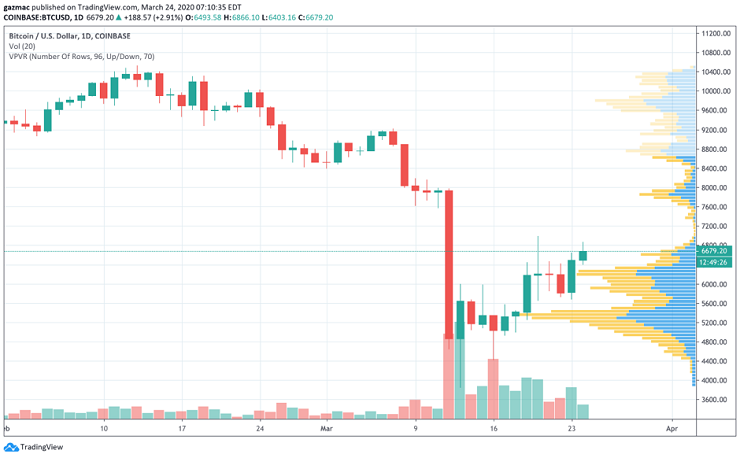Why this may be the time for bitcoin to shine
With central bank money-printing machines switched back on, might bitcoin be the star of the recession?
24th March 2020 13:50
by Gary McFarlane from interactive investor
With central bank money-printing machines switched back on, might bitcoin be the star of the recession?

Trading at $6,750, bitcoin has just acted as if it were a leading indicator for equities.
The bitcoin price bounced (for the second time in a week) yesterday when the US Federal Reserve announced open-ended asset purchasing, and its expansion into the corporate bond market by buying exchange traded funds (ETFs).
Notably, then, bitcoin’s shift higher began when equities were still printing red ink. US politicians proposing the creation of a crypto dollar may have helped too (see more below).
In the past 24 hours bitcoin is 13% the better. Gold is 6% higher today on the back of yesterday’s 5% surge, while equities are improving by 5%, at the time of writing.
Stocks are rebounding strongly as the prospect of more Fed largesse at least temporarily pauses the downturn and, despite delays, encouraged by the prospect of a recovery plan coming out of the US Congress sooner rather than later.
Significantly, gold also bounced with bitcoin yesterday, but even more strongly, for its largest daily move on record.
After bitcoin’s collapse this month in tandem with almost all other assets, putting in an intraday low of $4,400, it managed to reclaim $6,000 on 19 March.
It couldn’t hold there and sank again, back down to around $5,600 on 22-23 March.
Selling has been driven by equity investors raising cash, exaggerated by the fact that bitcoin remains a highly speculative asset.

(BTCUSD 1-day candle, Coinbase, 24 March 2020, courtesy TradingView)
Crypto – it’s still all about Covid-19 for now
Whether the bounce in both bitcoin and stocks holds will undoubtedly depend on progress in containing Covid-19 and handling the economic fallout.
That means it is probably still too early to call the bottom in equities, which bitcoin has been tightly correlated with these past couple of weeks.
But what about bitcoin? Today that correlation is still in effect, as both equities and crypto rise, but, as we have seen in bitcoin’s recent price movements, that may be loosening.
Although a dangerous sport to indulge in, bottom-calling on bitcoin may be easier to do at this juncture for other assets.
With the possibility of finding a low in the $3,000 area now further away, and perhaps many of those who wanted to raise cash finished with their selling, bitcoin may have the worst behind it.
Certainly, as we have previously noted, the top digital currency’s safe haven properties were found wanting, but so too were gold’s at the beginning of this bear market.
As it happens, the digital gold thesis is still very much intact and the significance of the synchronised jump yesterday after the Fed’s “do whatever it takes” moment, should be emphasised.
Indeed, it could be argued that bitcoin is in a stronger position than gold.
Crypto followers will be aware that the Fed’s reprise of QE takes us back to where it all began for bitcoin.
In short, the return of the money-printing machines – but on an even bigger scale – has the potential to truly make this the time for bitcoin to shine.
Bitcoin’s limited supply stands in stark contrast to central bank monetary policy. Add to that the halving in block rewards coming in May, and the asset’s “censorship resistance” becomes a big plus.
To put that in plain English, bitcoin could act as a hedge against inflation.
Bitcoin-gold theme will “run and run” says City figure Clem Chambers
Clem Chambers, chief executive of international private investor network ADVFN and crypto firm Online Blockchain, certainly thinks so.
In comments provided to interactive investor, Chambers said: “Bitcoin is ‘the new gold’ but there is a lot less of it than there is gold around the world. The initial rally in bitcoin was created by the demand from the Chinese rich as flight capital. That story is over and as soon as there was nowhere to go for these buyers they sold and down came BTC.
“Also creating a crash for BTC was the recent liquidity squeeze where any easily liquidated asset was sold for cash to make wage and margin calls.”
Chambers continued: “Now we are in a new dynamic: the ‘QE everything everywhere’ move by central banks to flood the world with cheap loans to keep the world from going bust in the new quarantined dystopia.
“Now investors are worried about inflation, and bitcoin and gold are rallying accordingly. This theme will run and run.”
But Chambers cautions that it is corona that dominates everything.
“In the background, the halvening* is fast approaching which is generating some updraft but that is nothing compared to the rolling saga of the coronavirus, which will drive all markets until further notice.”
* “halvening” refers to the halving of 12.5 bitcoins paid to miners in reward for verifying a transaction block to 6.25, thereby constraining supply. It is built into the bitcoin software and happens roughly every four years. Past halvings have led to price increases, but, as they say, past performance is not a guide to future performance.
Will bitcoin be a recession asset?
Another positive for bitcoin is the unwelcome fact that an increasing number of economies are going into recession (or are already there), especially those dependent on oil exports.
In the most bombed-out of those economies, where the local currency begins to sag, then bitcoin can assume a role as a uniquely accessible and liquid store of value, even if consumers and investors might be moving in and out as a bridging currency.
Then there is the wider issue of how opportunity emerges from crisis.
The Libra Association has not gone away, and neither has the looming launch of a central bank digital currency (CBDC) in China.
Although both are hated by crypto “true believers” as the bastard children of crypto, both in their own ways could help to popularise mass adoption of digital currencies, or at the least attract institutional interest to the sector.
Libra, contrary to previous assertions from Facebook, could still launch without regulatory backing in the US, perhaps from Switzerland. It could be backed by safe haven currencies other than the US dollar, such as the Swiss Franc and the yen.
Alternatively, the Libra Association sticks with the dollar route to market, but pressures the regulators while they may be a little distracted and gets the green light for its scaled back version of the original whitepaper iteration of the “stablecoin” digital currency.
With Shopify onboard – a company that provides merchant facilities to a huge range of online properties – Libra could pose as the sort of cost-saving payments solution that can help precisely those small firms worldwide that are being hardest hit by the corona crisis. And so too might a resurgent “real” crypto for cross-border transactions.
China set to internationalise the yuan using digital currency, US Democrats proposes digital dollar
As for China, the notion that it has beaten the virus is almost certainly overstated, and the collapse in industrial production and consumer demand will not recover as quickly as optimists expect.
In such an environment, the opportunity to “internationalise” the yuan that a central bank digital currency (CBDC) would offer and the finer control over monetary policy, may prove irresistible, bringing forward the launch.
But the big news this week was perhaps the stimulus draft proposal emerging from the House of Representatives in the US Congress. Democrat representatives have proposed the creation of a digital dollar as part of their plan.
The advantages of such an instrument would be the ease with which, for example, “helicopter money” could be distributed to consumers, as is planned in the various competing stimuli proposals.
In this corona virus moment, it is the credit markets that may be the weakest link – especially high-yield corporate debt. As such, limiting any damage there, and progress on the virus-containment front, are key market-health determinants.
If the current crisis morphs into a credit crisis, with rising corporate credit defaults, then the equity, bond and crypto markets will fall further still – which is why the Fed’s corporate bond-buying, including junk high-yield, is so critical.
Crypto investors will need to keep a keen eye on events beyond the world of crypto.
Bitcoin seemed to fail the initial shock of the virus, but may yet reclaim its footing to be the star of the recession, however long that might last.
These articles are provided for information purposes only. Occasionally, an opinion about whether to buy or sell a specific investment may be provided by third parties. The content is not intended to be a personal recommendation to buy or sell any financial instrument or product, or to adopt any investment strategy as it is not provided based on an assessment of your investing knowledge and experience, your financial situation or your investment objectives. The value of your investments, and the income derived from them, may go down as well as up. You may not get back all the money that you invest. The investments referred to in this article may not be suitable for all investors, and if in doubt, an investor should seek advice from a qualified investment adviser.
Full performance can be found on the company or index summary page on the interactive investor website. Simply click on the company's or index name highlighted in the article.